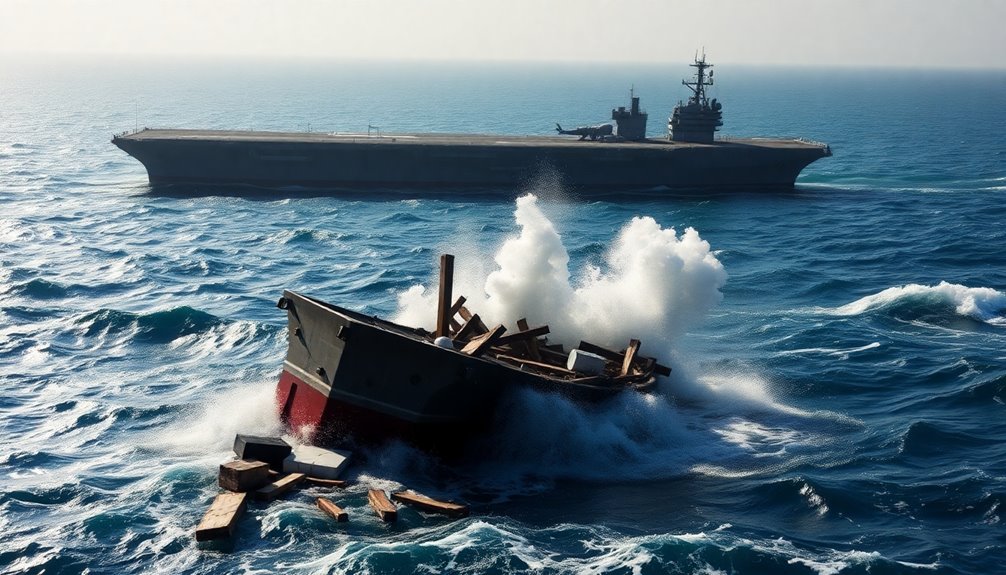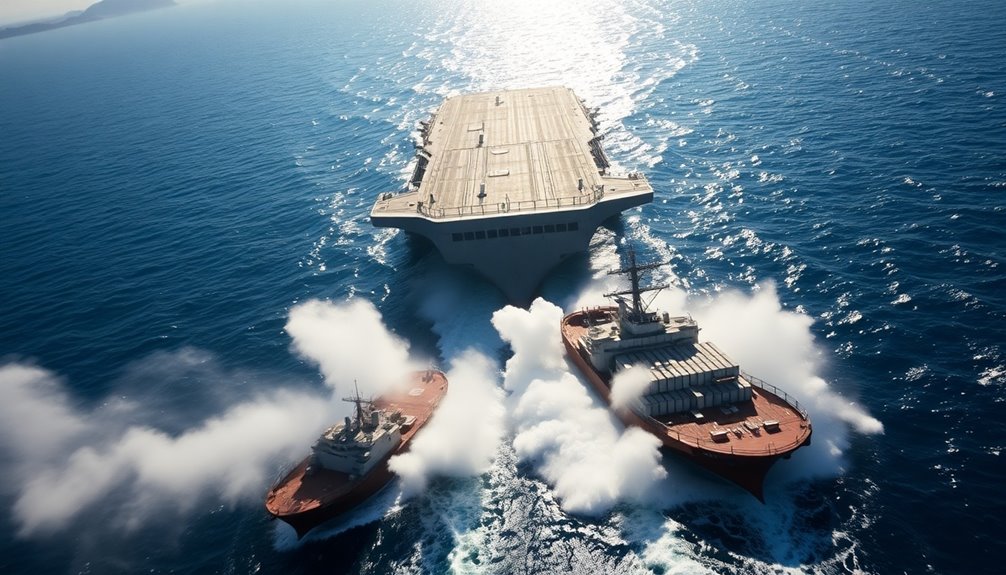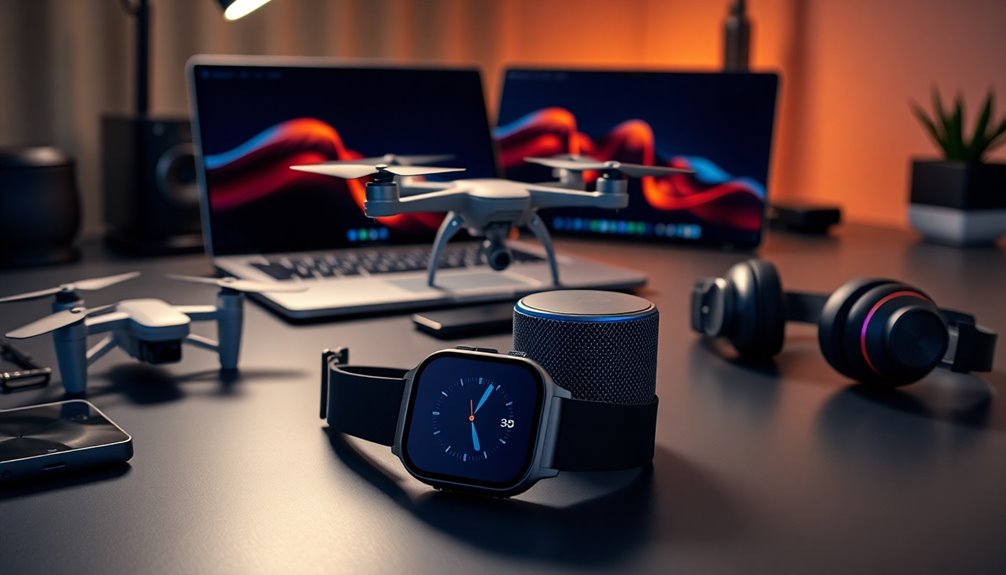The USS Harry S. Truman collided with the merchant vessel Besiktas-M near the Suez Canal, causing concerns over navigation safety in this busy waterway. The incident occurred as the carrier was preparing to reenter the canal, with around 100 ships present in the area, complicating maneuvers. Thankfully, there were no injuries reported, though the Besiktas-M sustained some damage. You'll find more about the implications and ongoing investigations surrounding this incident.
Key Takeaways
- The USS Harry S. Truman collided with the merchant vessel Besiktas-M near Port Said at 11:46 p.m. local time.
- No injuries were reported, but Besiktas-M sustained damage from the collision.
- The incident occurred in a crowded waterway with nearly 100 ships, complicating navigation.
- The collision raises concerns about safe maritime operations in the strategically vital Suez Canal.
- An investigation is underway to determine the causes and improve future maritime safety protocols.

Late Wednesday night, as maritime traffic surged near Egypt's Port Said, the USS Harry S. Truman, a massive Nimitz-class aircraft carrier, collided with the Besiktas-M, a 617-foot Panamanian-flagged merchant vessel. This incident occurred around 11:46 p.m. local time, amidst a crowded waterway hosting nearly 100 ships. Fortunately, no injuries were reported, but the collision did leave the Besiktas-M with some damage.
You might wonder how such an event could happen in a crucial maritime area like this, especially considering the USS Harry S. Truman had recently finished combat operations in the Central Command region. The carrier was preparing to reenter the Suez Canal and head back into the Red Sea when the accident occurred. Both vessels require significant space to maneuver and stop, complicating navigation in busy waters. The presence of approximately 100 ships in the vicinity at the time added to the complexity of the situation.
The Suez Canal is essential for global trade, with about 12% to 15% of it passing through daily, so any incident here raises concerns. The propulsion systems on the Truman remained unaffected, which is a relief given its strategic importance. The carrier had recently visited Souda Bay, Greece, and conducted airstrikes against Houthi rebels in Yemen and ISIS targets in Somalia.
The incident highlights the ongoing challenges of maintaining safety and security in heavily trafficked maritime areas. Currently, the incident is under investigation, and the findings will determine if any changes are necessary for maritime operations or safety protocols.
As you consider the implications, remember that this isn't the first time the Suez Canal faced disruptions; the Ever Given container ship famously blocked it for six days in 2021. With the USS Harry S. Truman's departure leaving Middle Eastern waters without a US aircraft carrier for the third time in 15 months, the situation underscores the strategic complexities of naval operations in such crowded waterways.
Frequently Asked Questions
What Safety Measures Do Aircraft Carriers Have to Prevent Collisions?
Aircraft carriers implement several safety measures to prevent collisions.
You'll find advanced air traffic control radar and collision avoidance systems, like TCAS, that track nearby aircraft.
Navigation and communication systems enhance coordination with air traffic.
Additionally, weather monitoring systems help predict conditions that could lead to accidents.
Crew training in crisis management and emergency response ensures that personnel are prepared to handle any situation effectively, further minimizing the risk of collisions.
How Often Do Naval Vessels Collide With Merchant Ships?
So, you think naval vessels and merchant ships are just playing bumper cars out at sea? Well, not quite!
While collisions are rare, they do happen occasionally—117 times in 2024, to be exact. Most incidents arise from crew errors or tricky weather, rather than a game of "who's got the bigger boat."
Despite their size, naval vessels aren't collision-proof, reminding you that even the mightiest can have a rough day on the water.
What Are the Consequences of Such Incidents for the Navy?
When naval vessels collide with merchant ships, you'll see several consequences for the Navy.
First, there's the financial impact, as repair costs and insurance claims can strain budgets.
Operationally, such incidents necessitate reviews of safety protocols and crew training.
You might notice changes in strategic planning to prevent future collisions.
Additionally, public perception can shift, leading to concerns about naval safety and international relations, making transparency crucial for maintaining trust.
How Is Navigation Managed Near the Suez Canal?
Did you know that around 50 ships pass through the Suez Canal daily?
Navigation management here relies on a combination of technologies and strict regulations.
You'll see the Automatic Identification System (AIS) and radar working together to monitor vessel movements closely.
Pilots guide ships, adhering to speed limits and prohibitions on anchoring.
Communication via VHF radio helps coordinate traffic, ensuring safety and efficiency in this vital maritime passage.
What Protocols Are in Place for Reporting Maritime Accidents?
When you're involved in a maritime accident, it's crucial to follow specific reporting protocols.
You must notify authorities immediately for serious incidents and file detailed reports within established timelines—usually within 48 hours for injuries or death, and five days for other significant casualties.
Use the appropriate forms like CG_2692 for commercial vessels or CG_3865 for recreational accidents.
Adhering to these regulations helps ensure safety and compliance in maritime operations.
Conclusion
In the shadow of the Suez Canal, the collision between the mighty aircraft carrier and the merchant vessel symbolizes the fragility of human endeavor amidst vast, unyielding waters. Just as ships navigate treacherous currents, so too must nations steer through the complexities of diplomacy and cooperation. This incident serves as a stark reminder that even the most formidable forces can falter, urging us to embrace vigilance and unity in our shared journey across the ever-changing seas of life. As we reflect on this maritime mishap, we are reminded of the importance of harmonizing strength with mindfulness, much like the serene balance found in balinese interior design features. These features not only prioritize functionality but also evoke a sense of peace and connection with nature. In a world often marked by chaos and competition, we must look to such principles of design and balance to cultivate environments that foster collaboration and mutual respect among nations.









